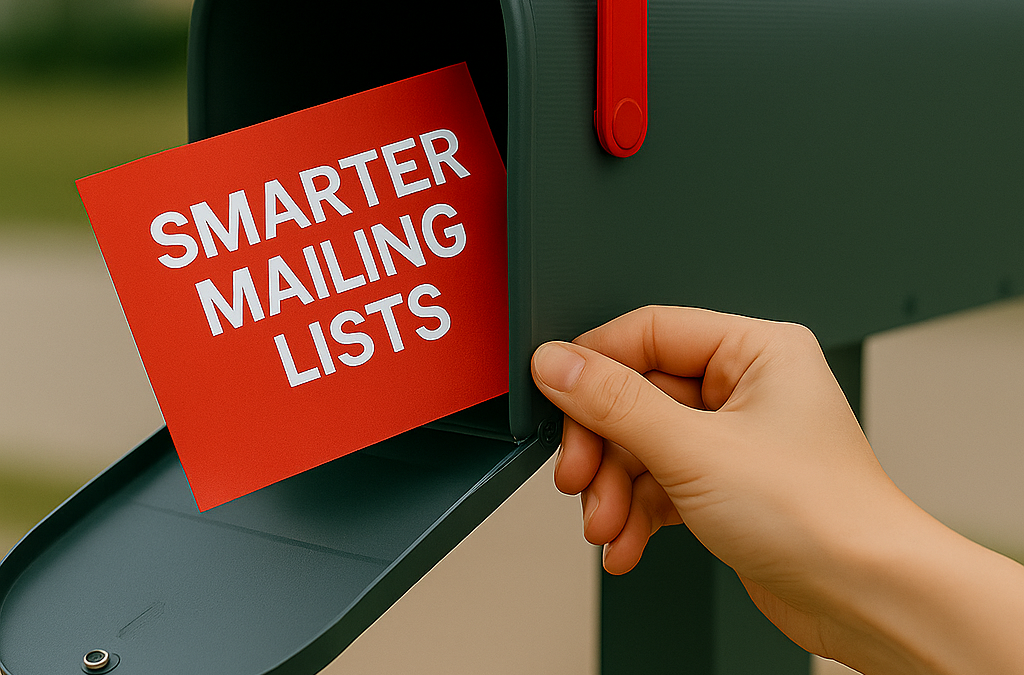Marketing campaigns succeed or fail based on one factor many businesses overlook: the direct mail mailing list. You can design the most eye-catching postcard or invest in premium finishes, but if it lands in the wrong mailbox, it won’t deliver results.
👉 If you missed Part 1 of this series, read “Direct Mail Tips for 2025”. In Part 2, we shared how to create Designs That Deliver.
Now, let’s look at the backbone of any direct mail campaign — your list — and how smarter targeting, better segmentation, and USPS tools can increase response and ROI.
Clean Mailing Lists Save Money
One of the biggest frustrations business owners face is wasted spend on undeliverable mail. An outdated or inaccurate list doesn’t just eat into ROI — it wastes printing, postage, and valuable opportunities. Rising USPS postage rates in 2025 only make clean data more important.
The solution lies in mailing list hygiene. Regular updates and verifications through tools like the National Change of Address (NCOA) system, CASS certification, and USPS Move Update compliance help keep addresses accurate. Deduplication ensures you’re not mailing the same household twice.
By maintaining a clean mailing list, you protect your budget and improve deliverability — one of the easiest ways to improve direct mail ROI.
Mailing List Segmentation: Why Targeted Direct Mail Performs Better
Even with a clean list, blasting the same postcard to everyone rarely works. That’s why mailing list segmentation has become a best practice for modern campaigns.
Segmenting your audience allows you to create targeted direct mail that resonates. You can break lists down by:
-
Geography (local neighborhoods, ZIP codes, or regional campaigns)
-
Demographics (age, household income, industry)
-
Customer type (loyal customers vs. new prospects)
-
Behavior (past purchases, website visits, event attendance)
A segmented list ensures that a loyal customer doesn’t receive the same generic message as a cold lead. Instead, your targeted mailing lists for small business deliver relevance — and that’s what drives higher response rates.
Personalized Direct Mail with Variable Data Printing
Segmentation is powerful, but personalized direct mail takes it further. Customers engage more when a mailer feels designed specifically for them. That’s where Variable Data Printing (VDP) comes in.
VDP lets you personalize names, headlines, offers, or even images at scale — all within one print run. For example:
-
A returning customer sees “Welcome Back!” with a loyalty discount.
-
A new prospect receives “First-Time Customer Offer.”
This approach makes campaigns feel more human and boosts engagement. Studies consistently show that personalized direct mail generates stronger response rates than generic campaigns.
Every Door Direct Mail (EDDM): Reach Without a List
Of course, not every campaign needs surgical precision. If you’re promoting a grand opening, community event, or neighborhood service, USPS Every Door Direct Mail (EDDM) can be the simplest path.
EDDM allows you to reach every household in a ZIP code or postal route — without owning a list. It’s especially effective for:
-
Restaurants
-
Local retailers
-
Nonprofits
-
Service-based businesses
When precision targeting isn’t required, the benefits of Every Door Direct Mail are clear: low cost, broad reach, and fast exposure in your local market.
Bottom Line: Smarter Lists, Better ROI
Your direct mail mailing list is the foundation of your campaign. A clean list saves money, segmentation makes your message relevant, personalization through VDP drives engagement, and USPS tools like EDDM expand your reach. When you manage your lists strategically, every dollar works harder — and your campaigns achieve stronger ROI.

